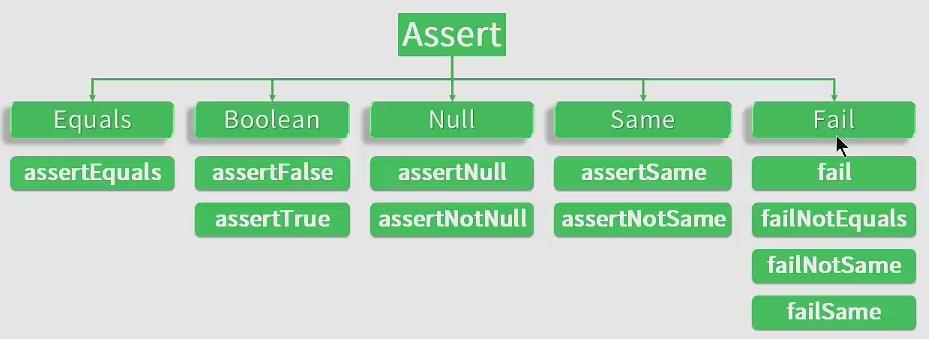10.Android UiAutomator Junit 断言函数的使用
Posted
tags:
篇首语:本文由小常识网(cha138.com)小编为大家整理,主要介绍了10.Android UiAutomator Junit 断言函数的使用相关的知识,希望对你有一定的参考价值。
一、断言函数介绍
1.断言函数:
确定被测试的方法是否按照预期的效果正常工作
- 比如说:
if (假设成立){ 通过测试 }else{ 报错并终止当前用例测试 }
2.断言函数用例结构:
- 一个完整的测试用例必需要有断言函数
setUp//初始化 //测试用例,junit4版本才可以使用多条用例 test 初始化场景与数据 test 模拟操作步骤 test 断言 test 恢复场景 tearDown//回收初始化垃圾
3.断言函数Java错误类型:
1)Error:
一般是指与虚拟机相关的问题,如系统崩溃,虚拟机错误,内存空间不足,方法调用栈溢出等。对于这类错误导致的应用程序中断,仅靠程序本身无法恢复和预防(断言)
2)Exeeption:
表示程序可以处理的异常,可以捕获且可能恢复。遇到这类异常,应该尽可能处理异常,使程序恢复运行,而不应该随意终止异常(最常见的是UI对象找不到的异常)
二、断言函数API:
1.断言函数分类:

- 例如:
//断言两个对象是否相等 asserEquals(String message,Object expected,Object actual){ if (expected==null && actual==null){ return ; } if (expected!=null && expected.equals(actual)){ return } failNotEquals(message,expected,actual); }
|
参数 |
说明 |
| Message | 可选消息,在断言失败后会抛出这个消息 |
| Expected | 期望的值 |
| Actual | 实际的值 |
2.相关API:
1)
| 方法 | 说明 |
| assertEquals(boolean,boolean) | 如果期望(expected)和实际(actual)相等则通过,否则失败 |
| assertEquals(String,boolean,boolean) | 如果期望(expected)和实际(actual)相等则通过,否则失败 |
| assertEquals(byte,byte) | 如果期望(expected)和实际(actual)相等则通过,否则失败 |
| assertEquals(String,byte,byte) | 如果期望(expected)和实际(actual)相等则通过,否则失败 |
| assertEquals(char,char) | 如果期望(expected)和实际(actual)相等则通过,否则失败 |
| assertEquals(String,char,char) | 如果期望(expected)和实际(actual)相等则通过,否则失败 |
| assertEquals(int,int) | 如果期望(expected)和实际(actual)相等则通过,否则失败 |
| assertEquals(String,int,int) | 如果期望(expected)和实际(actual)相等则通过,否则失败 |
| assertEquals(long,long) | 如果期望(expected)和实际(actual)相等则通过,否则失败 |
| assertEquals(String,long,long) | 如果期望(expected)和实际(actual)相等则通过,否则失败 |
| assertEquals(Object,Object) | 如果期望(expected)和实际(actual)相等则通过,否则失败 |
| assertEquals(String,Object,Object) | 如果期望(expected)和实际(actual)相等则通过,否则失败 |
| assertEquals(short,short) | 如果期望(expected)和实际(actual)相等则通过,否则失败 |
| assertEquals(String,short,short) | 如果期望(expected)和实际(actual)相等则通过,否则失败 |
| assertEquals(String,String) | 如果期望(expected)和实际(actual)相等则通过,否则失败 |
| assertEquals(String,String,String) | 如果期望(expected)和实际(actual)相等则通过,否则失败 |
- API示例:
public void testDemo1() throws UiObjectNotFoundException{ //断言相等的例子 assertEquals(5, add(2,3)); //断言不相等的例子 assertEquals(6, add(2,3)); } //新建一个加法方便使用断言函数 public int add(int a,int b){ return a+b; }
2)
浮点运算不是万全精确的,所以比较浮点数值的时候引入精确程度
assertEquals(double expected,double actual,double delta)
|
方法 |
说明 |
| assertEquals(double,double,double) | 如果期望(expected)和实际(actual)相差不超过精度值(delta)则通过,否则失败 |
| assertEquals(String,double,double,double) | 如果期望(expected)和实际(actual)相差不超过精度值(delta)则通过,否则失败 |
| assertEquals(float,float,float) | 如果期望(expected)和实际(actual)相差不超过精度值(delta)则通过,否则失败 |
| assertEquals(String,float,float,float) | 如果期望(expected)和实际(actual)相差不超过精度值(delta)则通过,否则失败 |
- API示例:
public void testDemo1() throws UiObjectNotFoundException{ //断言不相等的例子 assertEquals(0.3333, Double.valueOf(1)/3,0); //断言相等的例子 assertEquals(0.3333, Double.valueOf(1)/3,4); //断言相等的例子 assertEquals(0.3333, Double.valueOf(1)/3,0.0001); } //新建一个加法方便使用断言函数 public int add(int a,int b){ return a+b; }
3)
|
方法 |
说明 |
| assertFalse(boolean) | 如果条件(condition)为False则通过,否则失败 |
| assertFalse(String,boolean) | 如果条件(condition)为False则通过,否则失败 |
| assertTrue(boolran) | 如果条件(condition)为True则通过,否则失败 |
| assertTrue(String,boolran) | 如果条件(condition)为True则通过,否则失败 |
| assertNotNull(Object) | 如果条件(condition)为非空则通过,否则失败 |
| assertNotNull(String,Object) | 如果条件(condition)为非空则通过,否则失败 |
| assertNull(Object) | 如果条件(condition)为空则通过,否则失败 |
| assertNull(String,Object) | 如果条件(condition)为空则通过,否则失败 |
| assertNotSame(Object,object) | 如果期望(expected)和实际(actual)引用不同的内存对象对象则通过,否则失败 |
| assertNoteSame(String,Object,Object) | 如果期望(expected)和实际(actual)引用不同的内存对象对象则通过,否则失败 |
| assertSame(Object,Object) | 如果期望(expected)和实际(actual)引用相同的内存对象对象则通过,否则失败 |
| assertSame(String,Object,Object) | 如果期望(expected)和实际(actual)引用相同的内存对象对象则通过,否则失败 |
API示例:
//示例一: public void testDemo1() throws UiObjectNotFoundException{ //自己声明一个布尔值为了测试断言函数的使用 boolean is=true; //断言成功的例子 assertTrue(is); //断言失败的例子 assertFalse(is); } //示例二: public void testDemo1() throws UiObjectNotFoundException{ int a = 100; int b = 100; Integer c=new Integer(100); //断言成功的例子,值的比较 assertSame(a, b); //断言失败的例子 assertNotSame(a, b); //断言失败的例子,内存地址比较 assertSame(a, c); //断言成功的例子 assertSame((Object)a, c); }
4)
|
方法 |
说明 |
| fail() | 用例立即失败 |
| fail(String) | 用例立即失败,且抛出指定消息 |
| failNotEquals(String,Object,Object) | 用例立即失败,且抛出指定消息与期望、实际值不相等的消息 |
| failNotSame(String,String,String) | 用例立即失败,且抛出指定消息与期望、实际值不相等的消息 |
| failSame(String) | 用例立即失败,且抛出指定消息 |
- API示例:
public void testDemo1() throws UiObjectNotFoundException{ UiDevice.getInstance().pressBack(); UiDevice.getInstance().pressMenu(); UiDevice.getInstance().pressHome(); //用例失败,且抛出异常 fail("Failed"); }
三、使用断言函数的实例演示
//开始 protected void setUp() throws Exception{ super.setUp(); } public void testDemo1() throws UiObjectNotFoundException{ //初始化场景 UiDevice.getInstance().pressBack(); UiDevice.getInstance().pressBack(); UiDevice.getInstance().pressBack(); UiDevice.getInstance().pressHome(); //打开文件管理 UiObject app=new UiObject(new UiSelector().description("应用")); UiObject file=new UiObject(new UiSelector().text("文件管理器")); app.clickAndWaitForNewWindow(); file.clickAndWaitForNewWindow(); //验证开启成功 String packageName=UiDevice.getInstance().getCurrentPackageName(); assertEquals("File open succes!","com.cyanogenmod.filemanager", packageName); //检查目录名为test的目录 UiObject test=new UiObject(new UiSelector().text("test")); UiScrollable listView=new UiScrollable(new UiSelector().className("android.widget.ListView")); boolean FindResult=listView.scrollIntoView(test); //如果有该目录则停止执行用例 if (FindResult==true){ fail("test目录已经存在"); } //如果没有该目录则新建test目录 UiObject dos=new UiObject(new UiSelector().description("操作")); dos.clickAndWaitForNewWindow(); UiObject newFile=new UiObject(new UiSelector().text("新建文件夹")); newFile.clickAndWaitForNewWindow(); UiObject input=new UiObject(new UiSelector().className("android.widget.EditText")); input.setText("test"); UiObject ok=new UiObject(new UiSelector().text("确定")); ok.click(); //验证新建成功 boolean FindResult2=listView.scrollIntoView(test); assertTrue("test目录创建成功",FindResult2); } //完成 protected void tearDown() throws Exception{ super.tearDown(); UiDevice.getInstance().pressBack(); UiDevice.getInstance().pressBack(); UiDevice.getInstance().pressBack(); UiDevice.getInstance().pressHome(); }
以上是关于10.Android UiAutomator Junit 断言函数的使用的主要内容,如果未能解决你的问题,请参考以下文章